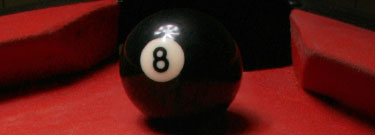By George Fels
[Reprinted from January 2006]
Nick varner was probably the first nationally ranked player I ever went up against in tournament play, and he celebrated that milestone with a 75-ball run good and early. I fashioned a 35 of my own in response, not bad at all for the way I was playing roughly 30 years ago, but still finished a well-beaten second in our match. In 1992, not quite 20 years later, I emceed his induction into the Billiard Congress of America Hall of Fame.
Nick is a four-year college man (Purdue University) playing professional pool, and after Max Eberle (James Madison) and Richard Lane (University of Oklahoma), that list grows dreadfully short. He and Eberle are the only former intercollegiate champions to re-surface in the professional game’s top echelons. And while few players are smaller physically (barely 5’7”, Varner was rejected for military service because he did not weigh the required 100 pounds), his record amply demonstrates that few have bigger hearts.
Unlike many of his fellow greats, Varner was not phenomenally good while phenomenally young. Born May 15, 1948, he grew up on a farm in southern Illinois and learned the game on the family’s basement table. When he left to enter Purdue in 1966, the game was so trivial to him that he did not touch a cue for nearly his entire freshman year. But the following spring, he meandered into the student union and accepted a challenge for some $1 9-ball. Six dollars later, he found out he had just beaten the current intercollegiate champion, Richard Baumgart. “I thought, ‘My goodness,’” he said (and that is exactly how he talks and thinks). “With a little patience…”
As a sophomore, Varner beat Baumgart but lost in the Association of College Unions-International (ACU-I) regionals. But his dedication to pool was reborn with a vengeance by then, and Purdue had a second shot maker to complement Varner’s classmate and famous hoops hero Rick Mount. Lafayette, Ind., home to Purdue, offered Varner not only the squeaky-clean tables and ambience of the student union, but also a downtown room called, appropriately enough, The Hole. No one seemed to know its formal name; in fact, just about the only people who knew of the room at all were established money players. There Nick launched his second education, aided in no small way by legendary hustler Hubert “Daddy Warbucks” Cokes.
As a college junior, and then a senior, Varner won consecutive national intercollegiate titles and was awarded a trophy very nearly as large as he was. More significantly, in 1969, the year of his second such championship, he appeared in an exhibition with all-time great Joe Balsis. They played a straight pool match to 150 points; needing just two more balls, Balsis made the mistake of giving the kid one more turn at the table. Varner stepped up and ran 58 consecutive balls to win, 150-148. Balsis was so upset that he demanded to gamble, something he was rarely known to do. Nick’s one-pocket lessons from Cokes paid handsome dividends — $200 — and the tiny Economics major had no further doubts about his true calling.
Following his graduation in 1970, Varner spent a few years giving exhibitions at shopping centers, country clubs and colleges; those were lean years for tournament pool. In 1972, he was married; in 1974, he joined his father as co-owner of a poolroom in Owensboro, Ky. Nick used that room as a home base, and augmented his income with up to 60 exhibitions a year, but virtually ignored the professional circuit, such that it was; there were barely a half-dozen real tournaments a year, and besides, as a new father, he wanted to spend more time with his family.
But by 1980 the tournament circuit had become considerably healthier, and Varner became a force. In that year alone, he won the Professional Pool Players Association 14.1 in New York, topping an almost exclusively East Coast field, and the BCA National 8-Ball Championship. He made $20,000 that year, a good amount by pool standards, and $25,000 each of the next two years.
But setbacks ensued. Varner lost his mother to a blood clot following surgery; not long after, he lost his wife to divorce. The events in tandem devastated him to the point where he played virtually no competitive pool for two years, although he continued to help tend to the family’s poolroom in Owensboro. But the dream that never quite evaporated, far more than making money at the game, was the idea of being called world champion, of being the best. He returned to professional pool in 1986 and made his presence felt at once, winning five of the 16 tournaments he entered, including another world straight-pool title.
But nothing prepared the pool world for what Varner accomplished in 1989. By then, straight pool had all but vanished from the tournament scene; the new competitive forum was 9-ball, in which luck is a considerably larger element, even if 9-ball does remain an extremely difficult, complex game. And in 1989, Varner won an astonishing eight major 9-ball titles — including four in six weeks. There has never been as dominant a performance since. To no one’s surprise, the major media in the billiards industry all named him Player of the Year. One year later, his peers honored him with the Professional Billiards Association Sportsperson of the Year award and, in 1992, he was inducted into the BCA Hall of Fame.
Today Varner is remarried, about to become a grandfather, continues to operate the Owensboro room and is a holy terror on the limited 50-and-over tournament circuit.
Nick Varner is lasting proof of the old bromide that life’s finer things often arrive in small packages.





